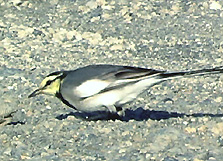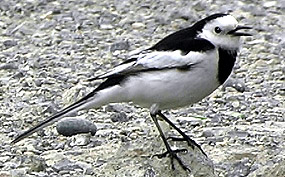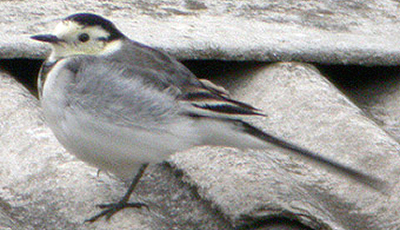
The following is an edited version of a mailing to the listserver OrientalBirding re the identification of the Alba/Lugens wagtails complex.
"A short note on Black-backed and "black-backed" White Wagtails in north-east Asia."
I wonder if there was/will be much response to Wayne’s interesting request about White Motacilla alba leucopsis and Black-backed Wagtail Motacilla (alba) lugens?
The alba/lugens wagtail complex seems extremely, well, complex, and opinions vary widely, with both taxonomy and field identification described differently (and even heatedly) depending on where you look.
What started as a few lines reply has therefore ended up rather more epic, based largely on personal experiences in Japan and South Korea. I hope it is useful in provoking further discussion, as it would be great to hear others’s views and improve on mistaken perceptions ... particularly now as many juvenile wagtails are once again on the move.
As far as I understand it, many authorities still consider lugens to be part of the Motacilla alba complex, apparently including the OBC, while others consider it to be a distinct monotypic species, Motacilla lugens, found breeding mostly in NE Asia, wintering slightly southward. Leucopsis is typically placed amongst White Wagtail and not with M. lugens.




In Japan, lugens is still generally considered part of the alba complex, presumably based on a combination of generally conservative taxonomy and on apparent extensive hybridisation between leucopsis and lugens within Japan, producing a range of types (often with only a partial black eye-stripe, or an eye-stripe on only one side of the face).
For Korea, the "Birds of Korea" field guide (Lee W-S, Koo T-H and J-Y Park, 2000) gives it specific status, while portraying lugens rather inaccurately (with e.g the female’s mantle coloration way too pale).
MacKinnon and Phillipps (2000) in their distinctive fashion seem to go deep into unknown territory, putting alboides and leucopsis in with Motacilla lugens (on account of the black "back" colour?) and even excluding southern Japan, Korea or the Russian Far East in their range map....
Although named Black-backed Wagtail, the key identification feature is supposed not to be "back" colour but actually the extent of the white on the upperwing, covering all but the (inner?) lesser wing coverts and primary tips in full adults. However, some (apparently pure) leucopsis can look remarkably similar in this respect. In addition, lugens’ vocalisations also appear reasonably distinct, but although adults in breeding plumage are quite distinctive (black eye-stripe, black upperparts, nearly all white wings), many in non-breeding plumage remain rather more difficult in the field to id than is sometimes suggested.
So how to separate them? Ocularis is the obvious confusion taxon in juvenile plumage/late autumn, sharing the black eye-stripe. This is unlike some other forms, such as the often range-overlapping leucopsis, which is open-faced.
In the field, in direct comparison, lugens appears shorter-legged than other albas, and more powerful looking, with a combination of apparently slightly larger size, deeper chest and flatter forehead. In my and others own basic research, it is thus typically dominant over other alba wagtails (alba wagtails often show clear hierarchy in flocks, old over young, male over female, and even female lugens tend to be dominant over male leucopsis and ocularis for example).
Lugens always shows black (breeding) or very dark grey (with darker patches)and never blue-grey or clean grey looking upperparts, and a rather more extensive bib than some other alba, which joins the neck sides (contra MacKinnon), with a clear or weak lower "crossbar".
Lugens (and leucopsis?) apparently takes 2 years to acquire the supposedly diagnostic almost all-white upperwings (ocularis shows more extensive dark), with juveniles and immature plumages however showing greyer and therefore apparently similar upperwings to other albas.
Lugens’ underparts in most (all?) ages do however look dirtier than in other alba,with a smokey-grey wash over the flanks, even in full adults. The rump can often appear slightly contrasting too.
The typical contact call of lugens is to my ear a little harder and less ’sweet’ than that of leucopsis or ocularis (not "chun-chun" as in MacKinnon but closer to "Tizs-it") and the subsong/song much longer and more rambling than at least that given by leucopsis.
Furthermore, again based largely on personal experience, lugens tends to prefer"energised" rocky areas: coastal zone and concrete river banks. If it is a ’good’ species, with a clear ecological niche, this would suggest that leucopsis at least (a taxon preferring more "gentle" environments, such as fields, wetlands, tidal-flat edge and lowland rivers) should perhaps not be considered part of lugens.
Lugens, however, is extending southward through Japan as a breeder, where it has interbred with and largely replaced leucopis, thus revealing overlap in potential territories/habitats. It is still near-exclusively a winter visitor and migrant in Korea (unlike leucopsis which is almost entirely a summer visitor, and ocularis which is common on Korean western islands in spring and also perhaps autumn?).
As can be inferred from the above, some lugens are easy, differences do exist, but experiences in autumn and with immature birds remain most frustrating...perhaps many individuals are better left simply as alba/lugens subsp?...


October 2, Photos © Nial Moores
Discussion:
Per Alstrom (Co-author of the Helm guide to Wagtails, Pipits, and Larks):
(Re the "presumed hybrid" illustrated above) "I agree it’s most likely to be a lugens X leucopsis hybrid (not necessarily F1)."
Will Duckworth:
"In addition to the points of confusion/uncertainty detailed here, it should also be pointed out that the image of alboides (whatever species they are saying it is) in MacKinnon & Phillipps’s "A Field Guide to the Birds of China", in fact shows a Mekong Wagtail Motacilla samveasnae(although the neck pattern is not quite right). Real alboides looks very different, and can be seen in (e.g.) Robsons FG to "Birds of SE Asia".



